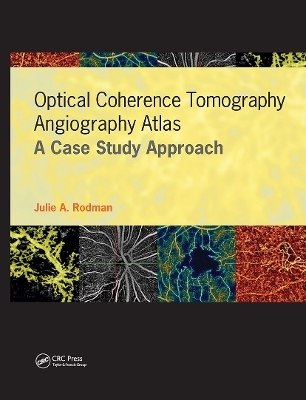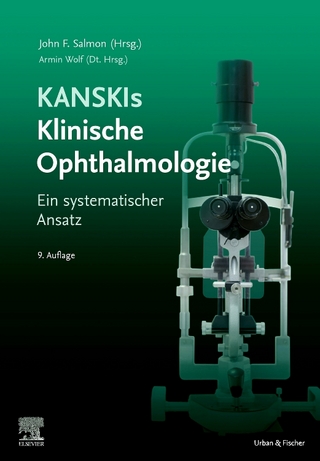
Optical Coherence Tomography Angiography Atlas
SLACK Incorporated (Verlag)
978-1-63091-641-1 (ISBN)
To fill this need, Optical Coherence Tomography Angiography Atlas: A Case Study Approach, by Dr. Julie A. Rodman, is a richly illustrated, practical guide to OCTA. It provides detailed information on the fundamental principles behind the technology, as well as clinical applications critical for accurate interpretation.
The first section of the book discusses the principles behind OCTA and provides an introduction into the interpretation of OCTA images, including a chapter devoted to terminology. The remainder of the book provides detailed analysis of a myriad of inner and outer retinal disorders, including diseases of the optic nerve head. Most importantly for the clinical setting, the cases are presented with numerous images and a multitude of arrows and callouts to assist in the recognition of various clinical findings.
Case examples include:
Vascular Occlusive Disease
Pigment Epithelial Detachment
Choroidal Neovascular Membrane
Diabetic Retinopathy
Optic Disc Edema
Dr. Rodman’s emphasis on the clinical use of OCTA technology and step-by-step interpretation of images makes Optical Coherence Tomography Angiography Atlas: A Case Study Approach a must-have resource for physicians, residents, students, and ophthalmic technicians looking for a simple, comprehensive guide to OCTA.
Julie A. Rodman, OD, MSc, FAAO graduated from Brandeis University (Waltham, Massachusetts) in 1994 with a BA in Neuroscience. She received her optometry degree from the New England College of Optometry (Boston, Massachusetts) in 1998. Dr. Rodman went on to complete a residency in hospital-based optometry at the VA Medical Center Brockton/West Roxbury, Massachusetts. Since completing her residency, Dr. Rodman has worked in various settings, including an ophthalmology private practice and an HMO-based practice. Dr. Rodman joined the Nova Southeastern University College of Optometry (Fort Lauderdale, Florida) in 2000 and now holds the rank of Professor of Optometry. During her tenure at Nova, she obtained her master’s degree in Clinical Vision Research. Dr. Rodman has assumed many roles at the College of Optometry. She has taught in the Optometry Theory and Methods Laboratory and currently serves as the Chief of the Broward Eye Care Institute in downtown Fort Lauderdale. She has been the recipient of numerous teaching awards, including the Golden Apple Award for Excellence in Clinical Precepting and Preceptor of the Year. Dr. Rodman has served as Residency Education Coordinator where she was responsible for arranging the didactic assignments for the Resident Conference Series as well as interdisciplinary presentations. Dr. Rodman is a residency supervisor and mentors the residents with grand rounds presentations, posters, and publications. Dr. Rodman is actively involved in the residency program and has served on the Residency Advisory Committee as well as the Association of Schools and Colleges of Optometry Residency Affairs Committee. Dr. Rodman has authored multiple posters at the American Academy of Optometry, American Optometric Association, Association for Research in Vision and Ophthalmology, Southeast Conference of Optometry, and Heart of America on various ocular disease topics. She became a Fellow of the American Academy of Optometry in 2007. She serves as a poster reviewer for the multi-media session at Southeast Conference of Optometry and is a reviewer for multiple index medicus journals as well. Dr. Rodman is a member of the American Optometric Association, Florida Optometric Association, and Optometric Retina Society. Dr. Rodman is a member of the Optovue Advisory Board, where she serves as a lecturer and consultant. She holds her Oral Pharmaceuticals Certification and is Laser Certified as well. Her scholarly interests include retinal disease, optical coherence tomography, optical coherence tomography angiography, and diseases of the vitreo-retinal interface. She was the principal investigator on a multi-center, nationwide investigation into the prevalence of vitreomacular adhesion in patients 40 years of age and older.
Dedication Acknowledgments About the Author Foreword by Daniel D. Esmaili, MDIntroduction?? Chapter 1 Optical Coherence Tomography Angiography Overview En Face Angiograms Retina High-Definition 6x6: Inner Retina Retina High-Definition 6x6: Outer Retina Optic Nerve Head High-Definition 4.5x4.5? Chapter 2 Optical Coherence Tomography Angiography Technology En Face Angiograms Inner Retina Outer Retina and Choriocapillaris Optic Nerve Head Scan Size Selection Retina 3x3 6x6 8x8 Montage Optic Nerve Head 4.5x4.5 6x6 Montage? Chapter 3 Comparison to Fluorescein Angiography Advantages of Optical Coherence Tomography Angiography Disadvantages of Optical Coherence Tomography Angiography? Chapter 4 Terminology En Face Projection Segmentation Slabs Slices Artifacts Projection Motion Shadowing? Chapter 5 Interpretation of Inner Retinal Disorders Normal Angiogram/Spectral-Domain Optical Coherence Tomography B-Scan Step-By-Step Analysis of Angiography in Inner Retinal Disorders Step 1: Evaluate the Optical Coherence Tomography Angiograms and B-Scans Step 2: Evaluate the Foveal Avascular Zone and Surrounding Area Step 3: Evaluate the High-Definition Widefield Montage? Chapter 6 Interpretation of Outer Retinal Disorders Normal Angiogram/Spectral-Domain Optical Coherence Tomography B-Scan Step-By-Step Analysis of Angiography in Outer Retinal Disorders Step 1: Evaluate the Optical Coherence Tomography Angiograms and B-Scans Step 2: Evaluate the Optical Coherence Tomography Angiography Report Step 3: Evaluate the Optical Coherence Tomography Angiography Report Step 4A: Evaluate the Optical Coherence Tomography Angiography Report Step 4B: Evaluate the Optical Coherence Tomography Angiography Report Step 4C: Evaluate the Optical Coherence Tomography Angiography Report? Chapter 7 Interpretation of Optic Nerve Head Disorders Normal Angiogram/Spectral-Domain Optical Coherence Tomography B-Scan Step-By-Step Analysis of Angiography in Optic Nerve Head Disorders Step 1: Evaluate the Optical Coherence Tomography Angiography Report? Chapter 8 Case Studies Inner Retinal Pathology Nonproliferative Diabetic Retinopathy Epiretinal Membrane Diabetic Macular Edema Hypertensive Retinopathy Severe Nonproliferative Diabetic Retinopathy Lamellar Hole Proliferative Diabetic Retinopathy Neovascularization Elsewhere Neovascularization of the Disc Vascular Occlusive Disease Branch Retinal Vein Occlusion Drusen Epiretinal Membrane Hemi-Retinal Vein Occlusion Central Retinal Vein Occlusion Neovascularization of the Disc/Optic Disc Edema Branch Retinal Artery Occlusion Epiretinal Membrane Epiretinal Membrane With Lamellar Hole Fibrous Proliferation Epiretinal Membrane With Lamellar Hole/Diabetic Retinopathy Macular Telangiectasia Type 2 Foveal Hypoplasia Outer Retinal Disease Dry Age-Related Macular Degeneration Drusen Epiretinal Membrane Cuticular Drusen Pigment Epithelial Detachment Drusenoid/Dry Age-Related Macular Degeneration Serous Pigment Epithelial Detachment/Dry Age-Related Macular Degeneration Serous Pigment Epithelial Detachment. Serous Detachment Central Serous Chorioretinopathy Serous Pigment Epithelial Detachment Chronic Central Serous Chorioretinopathy Geographic Atrophy Occult Choroidal Neovascular Membrane Choroidal Neovascular Membrane Occult Classic Polypoidal Choroidal Vasculopathy Retinitis Pigmentosa Mild Moderate Advanced Vitelliform Dystrophy Stargardt's Disease Dystrophy of the Retinal Pigment Epithelium Arcuate Pigment Epithelial Dystrophy Retinal Degeneration Solar Retinopathy Diseases of the Choroid Chorioretinal Scar Choroidal Rupture/Choroidal Neovascular Membrane Choroidal Nevus Optic Nerve Disease Primary Open-Angle Glaucoma Toxic Optic Neuropathy Optic Disc Pit Optic Atrophy Optic Disc Edema Malignant Hypertension Idiopathic Intracranial Hypertension Optic Nerve Melanocytoma Juxtapapillary Hamartoma of the Retinal Pigment Epithelium?? Index
| Erscheinungsdatum | 11.05.2019 |
|---|---|
| Verlagsort | Thorofare |
| Sprache | englisch |
| Maße | 216 x 279 mm |
| Gewicht | 811 g |
| Themenwelt | Medizin / Pharmazie ► Medizinische Fachgebiete ► Augenheilkunde |
| ISBN-10 | 1-63091-641-2 / 1630916412 |
| ISBN-13 | 978-1-63091-641-1 / 9781630916411 |
| Zustand | Neuware |
| Haben Sie eine Frage zum Produkt? |
aus dem Bereich


